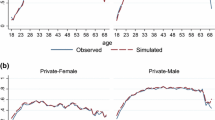Abstract.
Options for reforming unfunded public pension schemes that are now being discussed all share the feature that the burden induced by demographic change would be shifted towards presently living and away from unborn generations. Existing models of the political economy of pension reform can not explain why such reform options are being discussed at all. We present an alternative model in which the possibility of evasion of workers from payment of social security taxes is taken into account by modelling a labor supply function. It turns out that the burden of demographic change may fall completely or at least predominantly on the pensioners. Thus this type of model can much better explain recent trends in legislature on unfunded public pension systems in industrial democracies.
Similar content being viewed by others
Author information
Authors and Affiliations
Additional information
Received: 7 January 1999/Accepted: 20 December 1999
Rights and permissions
About this article
Cite this article
Breyer, F., Stolte, K. Demographic change, endogenous labor supply and the political feasibility of pension reform. J Popul Econ 14, 409–424 (2001). https://doi.org/10.1007/s001480000060
Issue Date:
DOI: https://doi.org/10.1007/s001480000060




